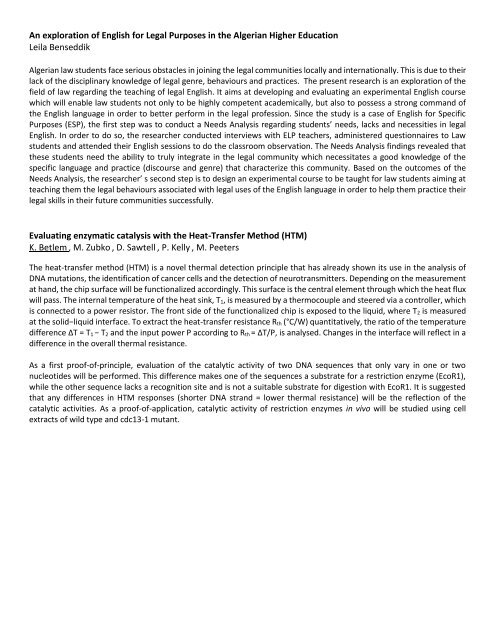Conference Programme FULL (1)
Create successful ePaper yourself
Turn your PDF publications into a flip-book with our unique Google optimized e-Paper software.
An exploration of English for Legal Purposes in the Algerian Higher Education<br />
Leila Benseddik<br />
Algerian law students face serious obstacles in joining the legal communities locally and internationally. This is due to their<br />
lack of the disciplinary knowledge of legal genre, behaviours and practices. The present research is an exploration of the<br />
field of law regarding the teaching of legal English. It aims at developing and evaluating an experimental English course<br />
which will enable law students not only to be highly competent academically, but also to possess a strong command of<br />
the English language in order to better perform in the legal profession. Since the study is a case of English for Specific<br />
Purposes (ESP), the first step was to conduct a Needs Analysis regarding students’ needs, lacks and necessities in legal<br />
English. In order to do so, the researcher conducted interviews with ELP teachers, administered questionnaires to Law<br />
students and attended their English sessions to do the classroom observation. The Needs Analysis findings revealed that<br />
these students need the ability to truly integrate in the legal community which necessitates a good knowledge of the<br />
specific language and practice (discourse and genre) that characterize this community. Based on the outcomes of the<br />
Needs Analysis, the researcher’ s second step is to design an experimental course to be taught for law students aiming at<br />
teaching them the legal behaviours associated with legal uses of the English language in order to help them practice their<br />
legal skills in their future communities successfully.<br />
Evaluating enzymatic catalysis with the Heat-Transfer Method (HTM)<br />
K. Betlem , M. Zubko , D. Sawtell , P. Kelly , M. Peeters<br />
The heat-transfer method (HTM) is a novel thermal detection principle that has already shown its use in the analysis of<br />
DNA mutations, the identification of cancer cells and the detection of neurotransmitters. Depending on the measurement<br />
at hand, the chip surface will be functionalized accordingly. This surface is the central element through which the heat flux<br />
will pass. The internal temperature of the heat sink, T 1, is measured by a thermocouple and steered via a controller, which<br />
is connected to a power resistor. The front side of the functionalized chip is exposed to the liquid, where T 2 is measured<br />
at the solid−liquid interface. To extract the heat-transfer resistance R th (°C/W) quantitatively, the ratio of the temperature<br />
difference ΔT = T 1 − T 2 and the input power P according to R th = ΔT/P, is analysed. Changes in the interface will reflect in a<br />
difference in the overall thermal resistance.<br />
As a first proof-of-principle, evaluation of the catalytic activity of two DNA sequences that only vary in one or two<br />
nucleotides will be performed. This difference makes one of the sequences a substrate for a restriction enzyme (EcoR1),<br />
while the other sequence lacks a recognition site and is not a suitable substrate for digestion with EcoR1. It is suggested<br />
that any differences in HTM responses (shorter DNA strand = lower thermal resistance) will be the reflection of the<br />
catalytic activities. As a proof-of-application, catalytic activity of restriction enzymes in vivo will be studied using cell<br />
extracts of wild type and cdc13-1 mutant.


